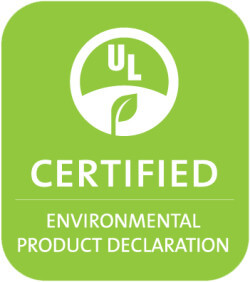Energy Efficiency & Sustainability
Solar Gard window film reflects significant solar energy, while absorbing another portion of the energy. The result is that the amount of solar radiation transmitted inside the room is considerably less. Specs will vary depending on the Solar Gard window film selected.
Only a few degrees in temperature reduction can have up to a 30% reduction in cooling costs, due to the laws of thermodynamics. It requires considerable amounts of energy to remove heat from a room through air conditioning. During peak summer times in the middle of the day, loads on air conditioning systems can be reduced enough to turn off entire units or to install a less costly system.
In addition to the energy saving benefits, solar window film can increase thermal comfort, reduce glare, while at the same time rejecting 99% of the UV radiation reducing fading and the risk of skin cancer.


In 2014, Solar Gard achieved an EPD (Environmental Product Declaration) certification from UL Environment, encompassing 41 architectural window film products. The EPD is based on a life cycle analysis of the cradle-to-grave impacts of Solar Gard’s products and fulfills the requirements of an ISO-compliant product category rule. The results are third-party verified per international standards (ISO 14044 and ISO 14025). Similar to a food label, an EPD provides a user with information on the environmental impacts and benefits of products.
The UL EPD certification mark indicates that UL has independently reviewed and certified the manufacturer’s environmental impact disclosure that constitutes the EPD. For more information, visit ul.com/epd
LEARN MORE
SOLAR GARD WINDOW FILM
A Sustainable Solution to Improving
Building Energy Efficiency
Compared to replacing windows, the embodied carbon of Solar Gard films is at least 30 times less than new windows. In addition to saving energy, Solar Gard’s architectural solar control window films are proven to be carbon negative and have a net positive environmental impact worldwide.
Because buildings are such a large source of carbon emissions, many building managers and home owners are concerned with reducing their carbon footprint.
In many cases, Solar Gard solar control window films are carbon neutral within one month of installation. Solar Gard window films are both carbon-effective and cost-effective, reducing a building’s carbon footprint more effectively and for less money than new windows and low-e coatings.
IN FACT:
- One square meter of a low-e wood window, the type with the smallest carbon footprint, has a carbon cost of 444 kilograms. The carbon cost of Solar Gard window film is less than one kilogram per square meter.1
- Solar Gard window film saves 100 times more GHG emissions from entering the atmosphere than is used and/or created during its manufacture.
- Solar Gard 46 Architectural solar control window film covered in the EPD sold during 2010-2011 will save 2.2 million tons of CO2 from entering the atmosphere over their lifetime.
THAT’S EQUAL TO:
the carbon attributed to combusting 221 million gallons of gasoline
the carbon offset by 50 million tree seedlings grown for 10 year
Whether your goal is to reduce operating costs, decrease carbon emissions or create a more comfortable and productive environment, understanding your options is critical.
Your buildings’ windows offer one of the best opportunities for a solid return on investment for energy savings. Solar energy enters through windows and causes heat to build up inside the building, leading to uncomfortable hotspots and an increased need for air conditioning.
With proven heat-rejection properties, Solar Gard architectural solar controlwindow films can help your home or business consume up to 30%¹ less energy for cooling, by keeping interior temperatures more stable. This reduces the need for air conditioning while moderating peak usage and allowing yourcooling system to operate more efficiently.
